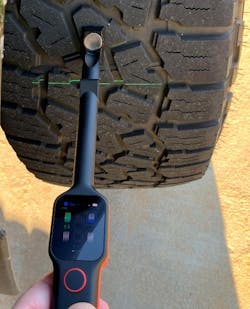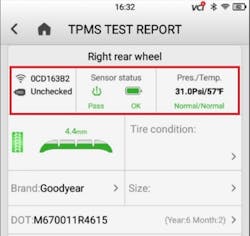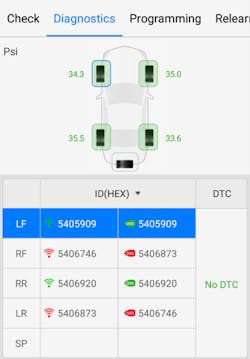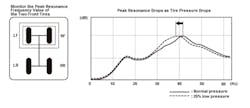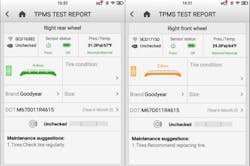Direct versus indirect TPMS: How they work and how to diagnose them
Content brought to you by PTEN. To subscribe, click here.
What you'll learn:
- The difference between direct and indirect tire pressure monitoring systems (TPMS)
- What tooling to use when servicing both types
- How a steering angle fault can turn on the low tire light and what to do about it.
Vehicles on the road today could have two possible types of tire pressure monitoring systems (TPMS). Either indirect meaning the vehicle has no pressure sensors in the tires or direct where the vehicle has individual sensors in each tire. Let’s take a deep dive into each of these systems and learn how they work and how to diagnose them.
Direct TPMS
Direct TPMS systems use individual pressure sensors in each tire mounted to the rim. Most of these sensors will be part of the valve stem although some early systems used a sensor mounted to the rim with a large band clamp. The sensors send out either a 315 MHz or 434 MHz signal. The signal is then received by the TPMS module which could be standalone or be built into another module — sometimes it may be built into the door lock receiver module or the radio transceiver module. The tire pressure data is then sent to the various modules that request it.
When servicing vehicles with direct TPMS, it is critical that service information be followed. On some vehicles the system may need to be calibrated when the tires are rotated, and others may ask that the system be reset even after tire pressures are changed. During this service I recommend using a tool that shows the battery state of health of the sensors like in Figure 1. Have you ever had a customer that came back after a tire rotation with a low tire light and now the car has a dead sensor? Once that happens, it becomes an “ever since you” scenario. If you look at the TPMS sensor battery level during routine service, you can catch the sensors before they die and let your customer know they need to be replaced.
In my opinion, it's not a bad idea to scan the sensors anytime the vehicle is in for an oil change just to check the batteries.
When a direct TPMS has a fault it’s easy to diagnose. If none of the sensors are being seen by the vehicle then we need to use a TPMS tool to check them and verify they are the correct sensor type/frequency and that they have a programmed ID number. Once that is done, if they aren’t correct or aren’t reading at all then they need to be replaced. If they are correct but the vehicle is not able to see them, then it could be a problem with the module or its input circuits. The module houses the antenna for the system. If the system is built into the remote door lock module, a simple test with the door lock remote can tell us if that module is functioning. If the door locks don’t work either, then we can head directly to the module and check all the inputs. If just one sensor is dead, then it’s easy to find with a tool that reads all the sensor information.
One thing I have personally seen is different brand sensors causing intermittent problems. I have seen some sensors that “go to sleep” while the vehicle sits overnight and then don’t wake up until the vehicle is at a certain speed. The tire light will be on when the customer starts the vehicle, but it may go off once up to driving speeds. If you run into this scenario, make sure the sensors are learned into their correct positions first. If the sensors are in the wrong position, like in Figure 2, it can cause you to chase the wrong sensor.
The left column of Figure 2 shows the actual position while the right column shows the position the ID is programmed to in the vehicle data. After this is checked, go for a drive while looking at live data for the sensors, the one that’s not reading pressure correctly is your culprit. To prevent this from happening I like to use OE sensors from companies like Schrader, Continental, and others. If an OE sensor isn’t available, then my go to is the Autel MX-1 TPMS sensors. These sensors combine 315 MHz and 433 MHz into one sensor and have only one SKU for easy inventory. There is nothing wrong with other aftermarket sensor options as well, but I have personally encountered problems that were caused by aftermarket sensors that were the incorrect part number for the application. The sensor was not faulty but was incorrect for the vehicle. When a supplier has many different part numbers, this is more likely to happen when the part numbers are entered into inventory at a parts store. That’s why I prefer OE or Autel’s simple one sensor approach.
Indirect TPMS
Now, let's look at indirect TPMS. Early systems looked at the difference in wheel speed via the ABS sensors to determine when a tire was low. As the tire loses air the circumference becomes smaller resulting in the wheel speed increasing. When that is recognized by the ABS module, a low tire light is displayed. The problem these systems had was they could only tell if one, two, or three tires were low, but they couldn’t tell if all four were low. This is because if all four tires gradually lost air, then they would all be the same circumference. Luckily for us, the indirect TPMS being used on new vehicles is substantially different from the earlier versions. Now, the system is integrated into the VSA modulator-control unit and uses the following inputs to monitor and compare tire characteristics to determine when one or more tires are significantly underinflated; VSA/ABS wheel speed sensors, Yaw and G sensor, brake pressure, steering angle, and outside temperature (measured from the front bumper) are all used.
From these inputs, the system calculates tire pressures. To determine tire pressure loss, the system uses these two methods: wheel speed differential and peak tire resonance. Wheel speed differential is calculated by performing a diagonal comparison between the front and rear wheels, a comparison between the two front and two rear wheels, and a comparison between the two right and two left wheels.
Peak tire resonance is basically the frequency that each tire is putting out and it is being measured by spectrum analysis of the wheel speed sensor data. To explain how this is calculated let's look at an excerpt from Honda’s OE service info: “Peak resonance values are learned during calibration and become the reference values for pressure monitoring. When using the frequency resonance method, the TPMS module compares the peak resonance values between all four tires and the two front tires. If the present values have dropped below a 25 percent pressure threshold, the low tire pressure/TPMS indicator turns ON. Resonance frequency is corrected based on the outside air temperature sensor information, because resonance frequency is changed by the outside air temperature.”
To better understand this relationship, look at Figure 3.
Because of this, they can tell if just one or all four tires are low as long as the system is calibrated properly. With these systems you MUST read service information and perform the calibration exactly as written. In one document published by Honda they state that the system could enter calibration on a new car when the pre-delivery service is performed, if the tires were not set to the correct pressure, then the vehicle will learn the pressures at say 65 psi instead of at the tire placard pressure. Honda says to perform calibration the tires must be set to the tire placard pressure only and the calibration should be performed any time the tire pressure is adjusted, or the tires are rotated or replaced. The tires must also be the correct size, same make/model on all four corners and tread depth must also match. (There is no tread depth spec difference given but it states tires must not be different tread depths)
Now, let’s look at diagnosing these systems. If the vehicle has a fault, first we need to look at the tire pressures, tire sizes, and tread depths. A variation in tread depth like shown in Figure 4 could potentially be a problem. Documenting things like this during routine service is a good idea as a CYA procedure as well. I use the Autel TBE200 and ITS600 to document this information for the customer (Figure 4).
After tires are checked, we need to make sure that the ambient temperature sensor is reading correctly and make sure there are no ABS or VSC system faults. To do this we would use a tool like the Autel MS909 to complete a system scan of all the modules. Then we would find the ambient sensor PID in live data. If the vehicle has an outside temperature read out, that can be used as well to verify. After this it’s a good idea to take the vehicle for a short drive and graph the wheel speed sensors to verify they are reading correctly as well. In the Autel MS909 you would go into the ABS module, select all 4-wheel speed sensors, and then select the graph merge option to look at all the sensors together on one graph. I prefer graphing data in comparison to looking at numerical data because if there is a drop out, it’s easier to catch.
Sometimes the factory scan tools offer faster refresh rate and better graphing so if you have access to those tools then that is the best option for graphing data. Through the research I did for this article (thanks to my good friend Chris Roberds) I was also alerted to a problem where a steering angle fault can turn on the low tire light. If the steering angle is off more than two degrees while driving straight, the tire light may turn on. According to several SAE documents and patents on indirect TPMS, these systems can measure steering torque and decide if a tire is low. The documents explain this in detail, but the manufacturers are vague about what methods are being used. Knowing that the Honda system will turn on the low tire light when steering angle is off, one can only assume the steering torque measurement might be used. A change in steering angle calibration could happen from a brush with a curb or maybe the steering angle reset was not carried out after an alignment.
When it comes to servicing these systems always replace all the tires at the same time, always use the OE size, always fill to the tire placard spec, and always perform the steering angle and TPMS calibrations when instructed by service information.
About the Author

Tanner Brandt
Tanner Brandt is an industry-leading diagnostics specialist and the CEO of Autodiag Clinic. By trade, he is an automotive diagnostic technician and technical trainer. Brandt has spent his career focused on researching automotive systems and strives to diagnose problems efficiently and accurately. When he isn't working on vehicles he is finding ways to pass along his knowledge and expertise to others through training and consulting. Brandt works with various companies throughout the automotive industry on solving problems, beta testing diagnostic equipment, and helping companies break into the automotive industry.
